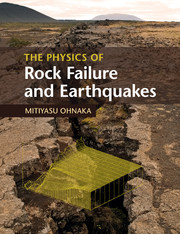Book contents
- Frontmatter
- Contents
- Preface
- 1 Introduction
- 2 Fundamentals of rock failure physics
- 3 Laboratory-derived constitutive relations for shear failure
- 4 Constitutive laws for earthquake ruptures
- 5 Earthquake generation processes
- 6 Physical scale-dependence
- 7 Large earthquake generation cycles and accompanying seismic activity
- List of illustration credits
- References
- Index
4 - Constitutive laws for earthquake ruptures
Published online by Cambridge University Press: 05 April 2013
- Frontmatter
- Contents
- Preface
- 1 Introduction
- 2 Fundamentals of rock failure physics
- 3 Laboratory-derived constitutive relations for shear failure
- 4 Constitutive laws for earthquake ruptures
- 5 Earthquake generation processes
- 6 Physical scale-dependence
- 7 Large earthquake generation cycles and accompanying seismic activity
- List of illustration credits
- References
- Index
Summary
Basic foundations for constitutive formulations
The constitutive law that governs the behavior of earthquake ruptures provides the basis of earthquake physics, and the governing law plays a fundamental role in accounting for the entire process of an earthquake rupture, from its nucleation to its dynamic propagation to its arrest, quantitatively, in a unified and consistent manner. Without a rational law to govern real earthquake rupture processes, the physics of earthquakes cannot be a quantitative science in the true sense. It is therefore of great urgency and importance to establish a rational law strictly formulated for real earthquake ruptures. In this chapter, we will review the constitutive formulations so far proposed for earthquakes, and will rigorously and thoroughly discuss what the governing law for earthquake ruptures ought to be, and how it should be formulated, on the basis of positive facts, from a comprehensive viewpoint. This is a necessary step toward the strict formulation of a constitutive law for real earthquake ruptures, and cannot be avoided if the physics of earthquakes is to be a quantitative science in the true sense.
A shallow earthquake source at crustal depths is a shear rupture instability taking place on a preexisting fault, in geological and tectonic settings, embedded in the seismogenic crust composed of rocks. As described in Chapter 1, the seismogenic crust and preexisting faults embedded therein are inherently heterogeneous. In particular, individual faults contain local strong areas (called “asperities” or “barriers”) that are highly resistant to rupture growth, with the rest of the fault having low (or little) resistance to rupture growth. Some local stress drops at these strong areas on faults are high enough to equal the breakdown stress drop of intact rock tested under seismogenic crustal conditions simulated in the laboratory (for example, see Figure 3.23). Hence, it is obvious that the earthquake rupture process at crustal depths is not a simple process of frictional slip failure on a uniformly precut weak fault, but a more complex process, including the fracture of initially intact rock at some local strong areas on a heterogeneous fault.
- Type
- Chapter
- Information
- The Physics of Rock Failure and Earthquakes , pp. 91 - 120Publisher: Cambridge University PressPrint publication year: 2013



